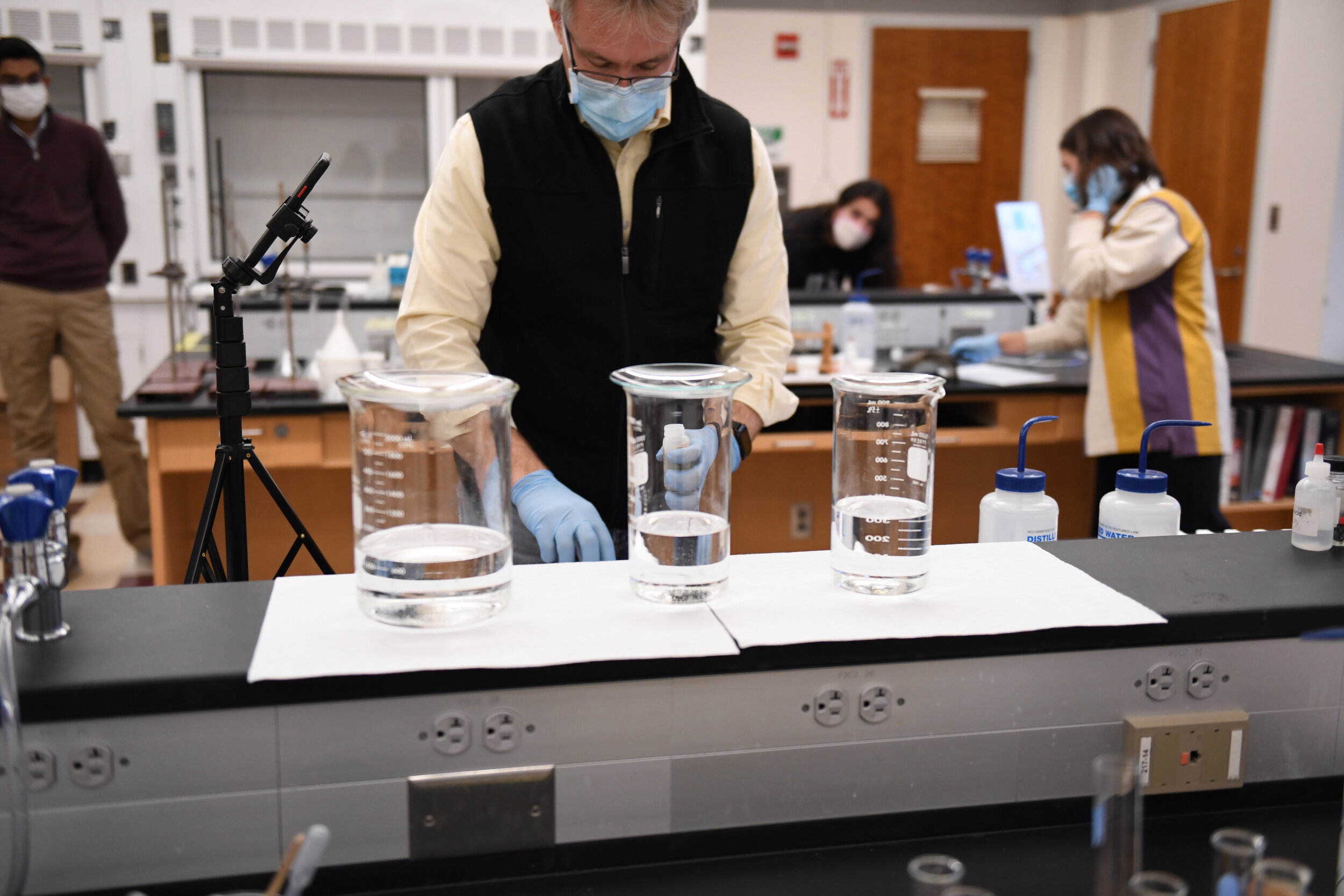Classes Pilot Hybrid Indoor Meetings
Dr. Jeff Ward performs an experiment with his students. Teja Vankireddy/The Exonian
By Taraz Lincoln, Emma Liu, Aanya Shahdadpuri and Hansi Zhu
The Academy recently provided all instructors with the option to host in-person classes. While some instructors were grateful for the opportunity to connect in-person, others noted difficulties integrating remote students and conducting Harkness discussions with masks and plastic dividers.
Because students are unable to abide by the six-foot distancing rule at the Harkness table, classrooms used for in-person instruction are equipped with Plexiglas dividers that separate chairs and table space. Other safety precautions within the classroom include mask-wearing, disinfecting surfaces after use and a one-way traffic flow inside all buildings. Classes are currently taking place in two primary buildings: the Phelps Center for science courses (predominantly lab work) and Phillips Hall for most others.
In order to provide the same immersive classroom experience to remote students, classrooms are also equipped with 360-degree cameras that broadcast all in-person students onto one screen through a Zoom call.
To many faculty members, conducting in-person classes was a return to normalcy. “I have been here for twenty years,” Spanish Instructor Jacqueline Flores said. “That’s all I’ve known and there’s nothing like teaching around the Harkness table. I miss seeing the students. I miss seeing all of our connections.”
Flores noted that in-person classes allowed students to experience more methods of learning. “When you’re teaching a foreign language, you have to be exposed not only to the language, but the explanation,” she said. “It’s one thing to explain online, but another thing is also meeting the needs of all students like those who need to learn visually.”
Science Instructor Townley Chisholm agreed. “In-person classes are what students came to PEA to do. Face-to-face conversations are so much richer than trying to guess when someone else might try to speak on Zoom,” he said. “We can read each others’ faces—even with masks on—and respond so much more naturally and effectively.”
Chisholm did not see in-person meetings as a significant infectivity concern either. “Right now, there seems to be zero risk of contracting COVID from students because they have all been tested a lot,” he said. “I could contract the virus on a trip to the grocery store, yet people are still buying groceries.”
Many students who have attended an in-person class this fall reacted positively to the new experience. Upper Kira Ferdyn highlighted the increased ability to form strong connections with her classmates. “I feel like [in-person classes] are a lot more immersive. As a new student, I feel like I’m trying to prioritize meeting people and connecting with people. And it’s really hard to do that on Zoom,” she said.
Ferdyn also mentioned the increased efficiency by which they were able to conduct class. “The teacher can come over and help you when you’re not understanding something and talk it through with you and have more of a one-on-one interaction,” she said. “I feel like we are able to troubleshoot things a lot more effectively in-person.”
Lower Chloe Becker said that being together with her classmates made class a more welcoming and focused environment. “I really love in-person classes because of the flow of conversation and how comfortable everyone is around their peers,” she said. “It makes me less stressed to come to class and even less so participating. I have massive amounts of anxiety over Zoom classes and in-person classes cut that stress in half.”
Upper Russell Tam noted the difficulty of taking classes online. “Although Zoom is very convenient, it’s hard to sit in front of a computer the whole day, and hard to absorb information well,” he said. “After going to in-person classes, I’ve also realised that many of us in class still don’t know the names of each other because there isn’t a Zoom name we can rely on.”
While some students have been enjoying in-person classes, others noted the inequity that they create for remote students. “It was nice to see classmates, but I don’t think it was very fair for those who weren’t on campus and had to Zoom,” senior Zoe Herman said. “I think it’s nice for science labs, but for most classes, it’s unnecessary.”
This has also been a problem for students studying remotely, according to remote upper Pedro Coelho. “I’d say the experience [with 360-degree cameras] was sub-par, simply because it’s harder to hear what each person is saying and because I can’t really see each individual person.” he said. “It’s more difficult to pick up on visual cues for Harkness learning.”
Lower and remote student Caleb Yu described “feeling distant from the class” during in-person meetings. “Online Zoom makes it hard to participate in labs, especially,” he said. “I would prefer to have a fully online class just so everyone is on the same page.”
However, in-person classes have not been perfect for those present, either. The necessity of masking and Plexiglass dividers restrict the clarity of in-person interactions. “Keeping in mind these regulations makes in-person interactions, especially in class, more difficult as, in addition to focusing on class material and learning, we must also abide by an extra set of rules that require constant attentiveness,” senior Suzan Unver said.
Despite this, Unver also emphasized the importance of the in-person experience. “On Zoom, it is difficult to get to know your class,” she said. “Class bonding is incredibly important at Exeter and has always been a defining feature of Harkness; without it, it feels as though I am taking classes alone and must teach myself most of what I am learning.”

